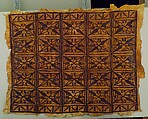Barkcloth Panel (Siapo)
Not on view
Created in myriad forms and varieties, Polynesian barkcloth, often referred to by the general term tapa, is produced almost exclusively by women. A paperlike textile predominantly manufactured from the soft inner bark of the paper mulberry tree, strips of which are pounded and then glued or felted together to produce large sheets, barkcloth was the only form of cloth in Polynesia prior to Western contact. Employed in virtually every aspect of daily and ceremonial life, Polynesian barkcloths are, or were, produced in countless forms and sizes, from smaller pieces used as garments or to wrap sacred or precious objects, to enormous ritual textiles displayed and exchanged as ceremonial gifts during important life passage rites, such as marriages and funerals. The present work is from Samoa, where barkcloth is known as siapo. While many of its former functions have been supplanted by the introduction of imported cloth, barkcloth continues to play a vital role in ceremonial life in many areas of Polynesia, especially in the western Polynesian archipelagos of Samoa, Tonga, and Fiji.
This image cannot be enlarged, viewed at full screen, or downloaded.

